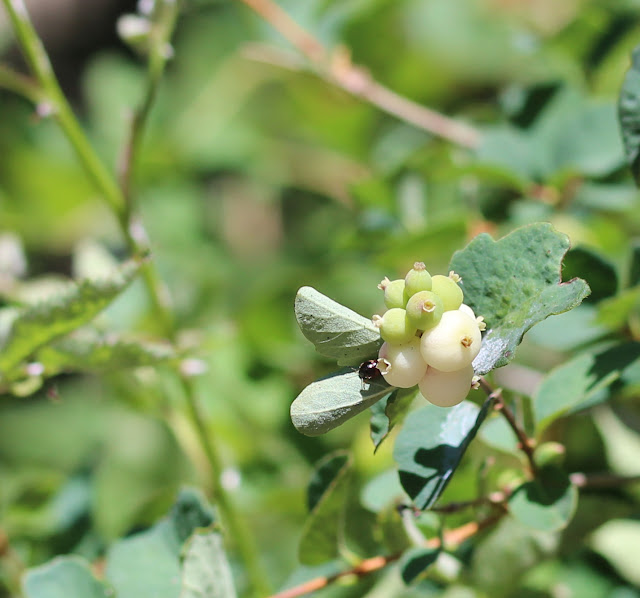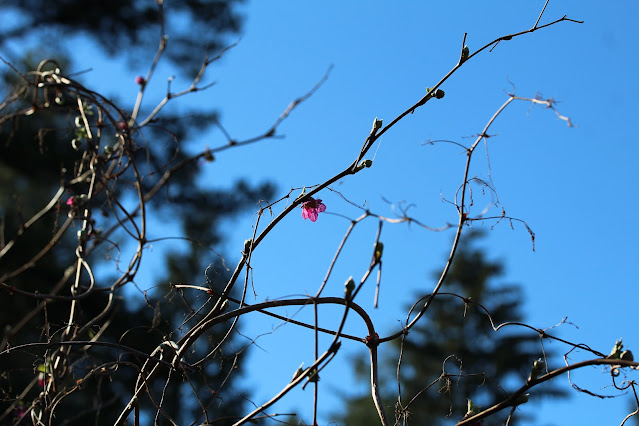 |
Bombus mixtus on Douglas Aster
|
When I started this project with hcma, a bee-centric delightful unburdening, it was the beginning of the foraging bee season on Vancouver Island and now we're coming to the end of the time when the bees are pollinating. It's the past the peak of summer, most of the fruit has been set and is starting to ripen, all thanks to the hardworking spring bees we saw in spring.
 |
The fuzzy fruit of hairy manzanita
|
We returned to the native plant garden at the Royal BC Museum to visit the plants and the bees one more time. It's amazing how many species of native plants the designers packed in this small space.
 |
The bracts of twinberry behind the tiny developing berries
|
Many plants are going to fruit or seed but there are a few blooming plants left in the garden: hardhack, Douglas aster, pearly everlasting, potentilla and snowberry. The summer bees are draining the last precious drops of nectar and ferrying the remaining pollen grains back to their nests.
As I surveyed the garden to prepare for the tour, I spot some little male hairy belly bees blending in with the grey rocks.
They are fast and don't perch for very long--just zooming around, drinking nectar and generally getting into trouble with the other insects in their hood.
 |
Photo by Darren Kirby
|
A group of the hcma staff came and met me on their lunch break. I did a show and tell of my recent cyanotypes and talked about some of the late season bee plants.
 |
Photo by Darren Kirby
|
I also challenged them to find a plant they have an affinity for--something that appeals to their senses, stimulates their memory and/or imagination and might want to explore more deeply. I talked about the resilience nature of arbutus and gumweed and how they inspire me.
 |
Photo by Darren Kirby
|
We took a look at the fruiting and flowering plants, including this lovely Oregon grape which has stunning foliage and fruit that could be considered a local super food.
The berries are great muddled in a sangria!
 |
common snowberry
|
Some berries, however, are best left for the birds--including the white fruit of common snowberry. This is an example of a long-blooming shrub that fruits and produces flowers at the same time.
We saw galls on the kinnikinnik, containing the eggs of an insect--probably a wasp--that alters the tissues of the plant.
The fruit of kinnikinnik or bear berries (Arctostaphylos urva-ursi) was once mixed with Saskatoon berries and fat to make pemmican.
Pincushion rose galls are made by a tiny wasp.
We saw the few remaining blooms of the intoxicating mock orange flowers. These are pollinated by Andrena mining bees and other insects.
 |
Photo by Darren Kiby
|
The design of the garden is layered with ground cover, perennials, short shrubs, tall shrubs and trees.
 |
| The cotton candy for bees: hardhack |
|
|
 |
Photo by Darren Kirby
|
I did manage to catch a female bumble bee on the hard hack, which we passed around for folks to have a closer look.
 |
Photo by Daren Kirby
|
 |
Photo by Darren Kirby
|
 |
Photo by Darren Kirby
|
Turns out the bee hot spot in the garden was in the potentilla. Most of the bees visiting this shrub were Bombus vosnesenskii.
We wrapped up the tour by looking at the gardens at the Empress hotel. Apart from the brown-eyed Susans (which may have been "nativars" in this case), everything was exotic and there were a few good bee plants such as purple coneflowers, zinnia, and Verbena bonariensis.
I also issued a hanging basket challenge: How can we create hanging baskets with plants that support bees and require less maintenance?
Here's a roundup of some of the plants I discussed: I encourage you to get to know the late season bee plants in your local area.
Late season bee plants: fireweed, gumweed, nodding
onion, aster, goldenrod, hard hack, yarrow, sneezeweed and pearly everlasting
Non-native Perennials:
Late season lavender, perennial sage, Russian sage, blanket
flowers, echinacea, oregano, mint, thyme, and asters
Exotic annuals: Zinnias, calendula and cosmos
Weeds: Clovers chicory, invasive Armenian (aka
Himalayan) blackberry, ragwort tansy, tansy, hairy cat’s ear, thistles and
ragweed.
So I leave you with this question: How can your deepening connection to bees and native plants influence your design process? I hope it leads to your own delightful unburdening!
I recently discovered this video about design based on biophilia, which you may find interesting: Biophilia: Letting Nature Encroach on Us
























%20(US%20Letter).jpg)






































